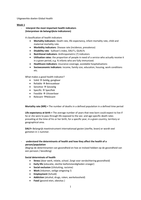Uitgewerkte doelen Global Health
Week 1
- interpret the most important health indicators
(Interpreteer de belangrijkste indicatoren)
A classification of health indicators
Mortality indicators: Death rate, life expectancy, infant mortality rate, child and
maternal mortality rate.
Morbidity indicators: Disease rate (incidence, prevalence)
Disability rate: Sullivan’s index, DALY’s, QUALYs
Nutritional indicators: Anthropometric (?) indicators
Utilisation rates: the proportion of people in need of a service who actually receive it
in a given period, e.g. % infants who are fully immunized.
Healthcare indicators: insurance coverage, avoidable hospitalisations
Socioeconomic indicators: income, family size, education, housing, work conditions
etc.
What makes a good health indicator?
Valid Geldig, gangbaar
Reliable Betrouwbaar
Sensitive Gevoelig
Specific Specifiek
Feasible Uitvoerbaar
Relevant Relevant
Mortality rate (MR) = The number of deaths in a defined population in a defined time period
Life expectancy at birth = The average number of years that new born could expect to live if
he or she were to pass through life exposed to the sex- and age-specific death rates
prevailing at the time of his or her birth, for a specific year, in a given country, territory or
geographical area.
DALY= Belangrijk meetinstrument internationaal gezien (sterfte, leven) er wordt veel
gemeten in 1 nummer.
- understand the determinants of health and how they affect the health of a
person/population
(Begrijp de determinanten van gezondheid en hoe ze invloed hebben op de gezondheid van
een persoon / bevolking)
Social determinats of health
Stress (door werk, relatie, school. Zorgt voor verslechtering gezondheid)
Early life (educatie, slechte leefomstandigheden vroeger)
Social exclusion (Uitsluiting, racisme)
Work (Inkomen, veilige omgeving !)
Employment (Schuld)
Addiction (alcohol, drugs, roken, werkeloosheid)
Food (gezond eten, obesitas )
1





